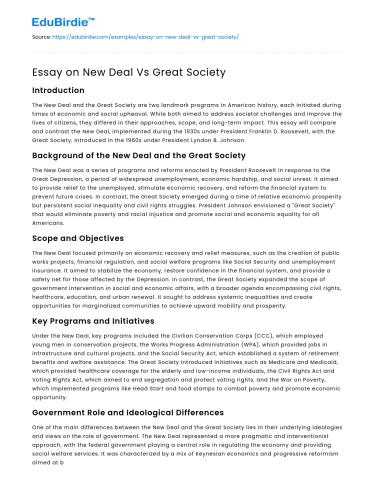Introduction
The New Deal and the Great Society are two landmark programs in American history, each initiated during times of economic and social upheaval. While both aimed to address societal challenges and improve the lives of citizens, they differed in their approaches, scope, and long-term impact. This essay will compare and contrast the New Deal, implemented during the 1930s under President Franklin D. Roosevelt, with the Great Society, introduced in the 1960s under President Lyndon B. Johnson.
Background of the New Deal and the Great Society
The New Deal was a series of programs and reforms enacted by President Roosevelt in response to the Great Depression, a period of widespread unemployment, economic hardship, and social unrest. It aimed to provide relief to the unemployed, stimulate economic recovery, and reform the financial system to prevent future crises. In contrast, the Great Society emerged during a time of relative economic prosperity but persistent social inequality and civil rights struggles. President Johnson envisioned a "Great Society" that would eliminate poverty and racial injustice and promote social and economic equality for all Americans.
Save your time!
We can take care of your essay
- Proper editing and formatting
- Free revision, title page, and bibliography
- Flexible prices and money-back guarantee
Scope and Objectives
The New Deal focused primarily on economic recovery and relief measures, such as the creation of public works projects, financial regulation, and social welfare programs like Social Security and unemployment insurance. It aimed to stabilize the economy, restore confidence in the financial system, and provide a safety net for those affected by the Depression. In contrast, the Great Society expanded the scope of government intervention in social and economic affairs, with a broader agenda encompassing civil rights, healthcare, education, and urban renewal. It sought to address systemic inequalities and create opportunities for marginalized communities to achieve upward mobility and prosperity.
Key Programs and Initiatives
Under the New Deal, key programs included the Civilian Conservation Corps (CCC), which employed young men in conservation projects, the Works Progress Administration (WPA), which provided jobs in infrastructure and cultural projects, and the Social Security Act, which established a system of retirement benefits and welfare assistance. The Great Society introduced initiatives such as Medicare and Medicaid, which provided healthcare coverage for the elderly and low-income individuals, the Civil Rights Act and Voting Rights Act, which aimed to end segregation and protect voting rights, and the War on Poverty, which implemented programs like Head Start and food stamps to combat poverty and promote economic opportunity.
Government Role and Ideological Differences
One of the main differences between the New Deal and the Great Society lies in their underlying ideologies and views on the role of government. The New Deal represented a more pragmatic and interventionist approach, with the federal government playing a central role in regulating the economy and providing social welfare services. It was characterized by a mix of Keynesian economics and progressive reformism aimed at balancing the interests of labor, business, and government. In contrast, the Great Society embraced a more ambitious vision of social justice and equality, with an emphasis on government-led initiatives to address systemic injustices and promote social welfare. It reflected the liberal ethos of the 1960s, with a focus on civil rights, anti-poverty measures, and expanding the social safety net.
Legacy and Long-Term Impact
The New Deal had a profound and lasting impact on American society, laying the foundation for the modern welfare state and reshaping the relationship between government and the economy. It helped mitigate the effects of the Great Depression and provided crucial support to millions of Americans during a time of crisis. The Great Society, while less successful in achieving its lofty goals of eradicating poverty and ending racial discrimination, nevertheless made significant strides in advancing civil rights, expanding access to healthcare and education, and promoting social justice. Its legacy continues to shape debates over the role of government in addressing social and economic inequality in contemporary America.
Conclusion
In conclusion, the New Deal and the Great Society represent two distinct eras in American history marked by efforts to address societal challenges and promote social and economic progress. While both initiatives shared a commitment to improving the lives of citizens and expanding the role of government in addressing social welfare issues, they differed in their approaches, objectives, and long-term impact. The New Deal focused on economic recovery and relief measures during the Great Depression, while the Great Society sought to address systemic inequalities and promote social justice during the civil rights era. Despite their differences, both programs left a lasting legacy on American society and continue to influence debates over government policy and social welfare to this day.






 Stuck on your essay?
Stuck on your essay?

